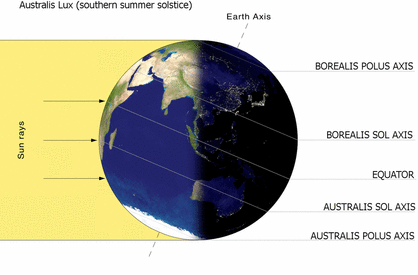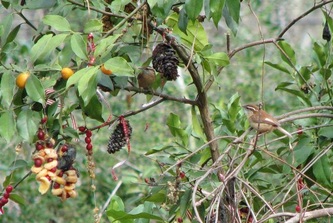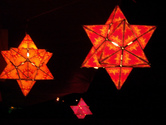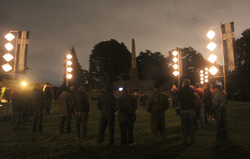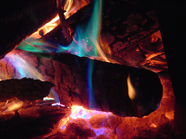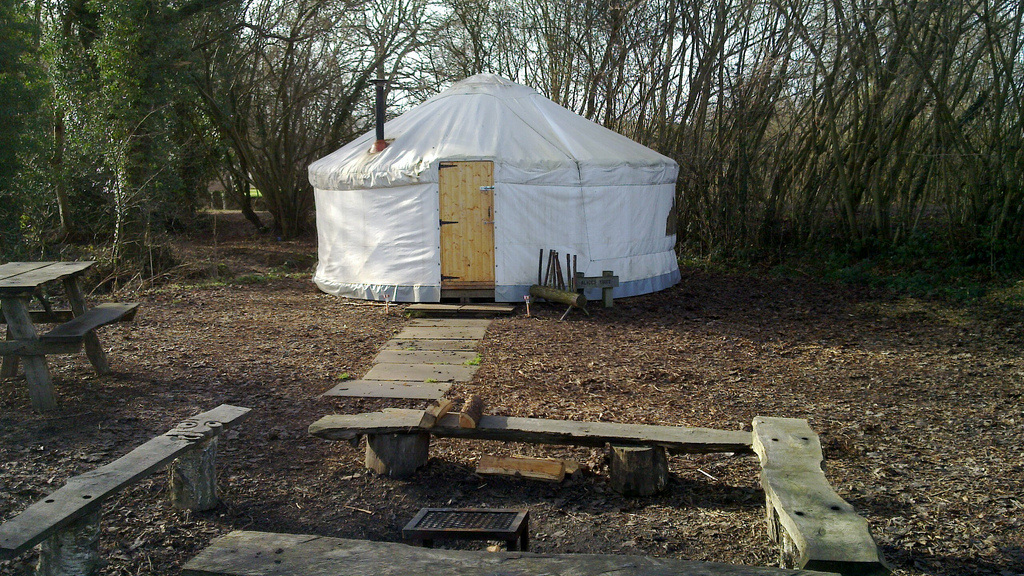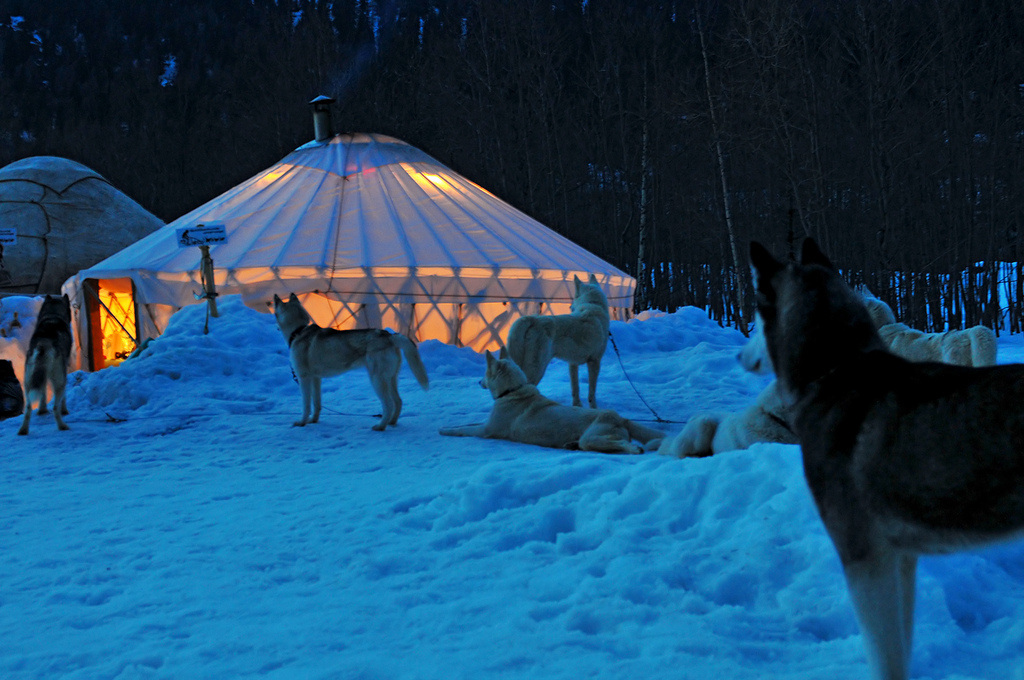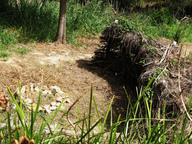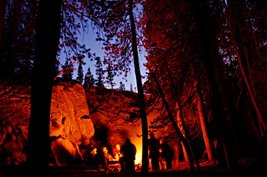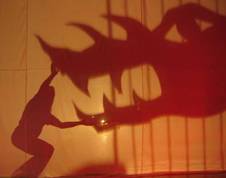Below describes one way of celebrating Nox, but this is not the only way to celebrate.
You may celebrate in your own way.
Consider the following as merely one way of celebrating and as a source for inspiration.
You may celebrate in your own way.
Consider the following as merely one way of celebrating and as a source for inspiration.
NOX
|
WHAT IT IS AND WHEN
Click on images to view in greater detail
Follow this link to learn more about the Ehoah Kalendars
Follow this link to learn more about the Ehoah Kalendars
What Nox Celebrates
Nox is the longest night of the year and in life the “darkest time” is considered death. But, this is also when the days begin to get longer, and it is new life that is seen as the new light. This connects the subject of death and conception, which connects to the topic of deep ancestry – how the cycle of life and death have made our cosmos – how the death of a star made our solar system, planet, life, and how that life was able to expand on our planet through the death of other life, building upon their nutrient in the environment – soil.
Nox is a a time to remember those who came before us, whose bodies have provided nourishment that aid in creating a richer environment for new life. It is also a celebratory time for those who have conceived, announcing the news (especially for those who have bonded at Transequinox, as it is past the first trimester when pregnancy is most at risk of miscarriage) and are celebrated along side those who have dispersed. The cycle of life and death renewed. The Cosmic History is retold and celebrated during these longest nights of the year when you can take a moment to look up at the night sky and appreciate what is before you and remember that you are star dust.
Nox is a a time to remember those who came before us, whose bodies have provided nourishment that aid in creating a richer environment for new life. It is also a celebratory time for those who have conceived, announcing the news (especially for those who have bonded at Transequinox, as it is past the first trimester when pregnancy is most at risk of miscarriage) and are celebrated along side those who have dispersed. The cycle of life and death renewed. The Cosmic History is retold and celebrated during these longest nights of the year when you can take a moment to look up at the night sky and appreciate what is before you and remember that you are star dust.
NOX DECORATIONS
Nox 'Tree'
 Public Photo
_For Nox Eve, decorate a tree (or any other prominent plant in your region i.e. cactus, vine, shrub etc.) outside with food stuffs for our distant relations - wildlife - to enjoy. The ways in which to decorate may be endless and a great way to express creativity. To the right are some designs already out there, and can be a source for further inspiration. Hover over or click on the images to learn more about them.
Below the images on the right is a free pdf on different ways to decorate your tree for birds. |
| ||||||
Bells

Bells of various shapes and sizes are used in every way imaginable to decorate for Nox. On doors, cupboards, drawers, shoes, hats, belts, jewelry, on pets and livestock, as wind chimes, wreaths, tree ornaments, and more.
Jingle bells are particularly associated with this time of year. Having been favored for being easy to ring and difficult to muffle, they were used to hear each other during the long winter nights. Especially in cooler climates as sleigh bells to warn other drivers and people walking along the narrow roads. In fact, many places had laws that required jingle bells on sleighs for safety. There are even a few places in Canada that still have these laws on their books.
Jingle bells are particularly associated with this time of year. Having been favored for being easy to ring and difficult to muffle, they were used to hear each other during the long winter nights. Especially in cooler climates as sleigh bells to warn other drivers and people walking along the narrow roads. In fact, many places had laws that required jingle bells on sleighs for safety. There are even a few places in Canada that still have these laws on their books.
Seasonal Greenery & Wicker

Most temperate regions have few remaining species of plant that remain green at the time of Nox, making whatever is left something that is valued as it reminds us of the lush vibrant times of the year and in turn makes us feel more lush and vibrant when surrounded by it. Evergreens (plants that stay green year round such as spruces, pines, cedars, and ivies) are taken as clippings of sprigs and boughs, often made into wreaths and garlands, to be brought indoors and hung out of doors to create this atmosphere. These clippings are done in such a way that no more than a third of the plant or plants are taken, and change up the source of clippings from year to year to ensure they will always be there in years to come.
To acknowledge that indeed most plants are not full of foliage during Nox, wicker decor is used as well. Combining the two in decorations makes us innately aware of the reality of the time of Nox.
To acknowledge that indeed most plants are not full of foliage during Nox, wicker decor is used as well. Combining the two in decorations makes us innately aware of the reality of the time of Nox.
Mirrors & Metallic Surfaces with Candles & Lamps

Mirrors and Metallic surfaces maximize the amount of indoor light from the sun during the short days and the amount of light emitted from a lamp or candle during the long nights. Providing a little sanity and creature comfort for us diurnal animals. Reflective objects that are suggestive to starlight is used to reflect the night environment. A simple method to increase the amount of light in a home is to use the glass in picture frames as mirrors and place them high in the corner of a room, facing toward the rest of the room, with a candle in front of it. For a little investment you can put in corner mirrors that are placed in ceiling corners to passively maximize the amount of light in your home year round.
Beeswax candles are most favored because of their ability to burn slowly and therefore longer periods (which is more affordable), is clean burning (no soot), is paraffin free (paraffin is made from petroleum sludge - a pollutive and non-renewable resource), is non-Toxic, and non-Carcinogenic.
The most favored oil for lamps are plant based oils, being free of petroleum, and is not volatile.
Beeswax candles are most favored because of their ability to burn slowly and therefore longer periods (which is more affordable), is clean burning (no soot), is paraffin free (paraffin is made from petroleum sludge - a pollutive and non-renewable resource), is non-Toxic, and non-Carcinogenic.
The most favored oil for lamps are plant based oils, being free of petroleum, and is not volatile.
Nocturnal Creatures

Being diurnal we usually don't experience the nocturnal creatures. By getting to know who the nocturnal creatures are and what they are like, we can have better relationship with the night and its associated life. One way of starting a positive relationship with these creatures is to dress up like them. Coming face to face with their forms is an opportunity to become more familiar with what they look like and diffusing what fears may have been previously present from disassociation.

Another way of establishing a positive relationship with nocturnal creatures is to engage with them directly. Presenters of native nocturnal species come by and allow people to see, touch, and handle them to familiarize with their behaviour and needs. It is also a good jumping point to learn what you can do to better the lives of your local night time neighbours.
Galaxy Costume
This is a time when we are most aware of the night, and thus outer space that brings a view of the stars beyond our sun. This makes it a good time to contemplate how stars are the source of the many atoms that make up the universe, that make up the chemicals on earth, that themselves make up the biology of life, our lives. That our origins come from the remnants of those stars that came before the ones we see in the night sky gives much reason to celebrate this time of the night sky. So costumes and make up are worn that are themed on the universe, galaxy, night sky, and stars to remember and celebrate that we are star stuff.
|
|
|
NOX FESTIVAL
The Nox Festival begins at Dusk/Nightfall
continuing through the night ending at Dawn/Daybreak.
All electrical light devices are absent from the festival
Being solely lit by flames from lanterns, lamps, and candles.
Phones are encouraged to be turned off in order to
keep our full attention on experiencing each other and the festival
Organize A Nox Festival Where You Are!
OPENING CEREMONY
The Nox Vigil
Everyone
gathers right before Nightfall at a location that is a 15 minute or
longer leisure walk from the festival grounds. A program is distributed
so everyone knows what is expected when participating and what is going
on throughout the festival. The program also includes a map of the
grounds and solstice songs which are sung throughout the walk.
Participants are encouraged to don jingle bells around their wrists,
ankles and garments to enhance the auditory experience.
Everyone silently watches as the horizon moves past the sun, acknowledging the ending of the shortest day of the year and the beginning of the longest night. Once the sun is out of view everyone lights their candles, lamps, and lanterns and begins to walk to the festival grounds. During the walk folks along the way join up with the main group. Each community charity, club and social group have their own poled lamp, decorated with jingle bells, images and objects they are associated with (i.e. soup kitchen having ladles on their poled lamp). This provides an opportunity for members of the community to come to know the various groups and organizations within it. Each poled lamp can be staked around the festival grounds in predesignated locations to promote overall visibility. Once arriving on the festival grounds, all the lights are blown out. There is then a moment of silence in the dark, acknowledging this longest of nights and respecting this time of transition. This is called the ‘silent night’. |
Lighting The Noxfire

Public Photo
After a time of the silent night, and while still maintaining silence, a predetermined individual (who has prepared for this) steps out in front of the crowd, lights an arrow, and shoots it into the pile of wood, lighting the Noxfire. Cheers break out as it brightens. Celebrating the beginning of the Festival, the last of the long nights, and the beginning of lengthening days.
The archer is usually determined by being champion of the fire archery competitions from the previous year. If it is the first year doing this, one option is to have all archers competing that year stand shoulder to shoulder in a straight line, with everyone else behind them, and shoot a flaming arrow at the same time into the wood pile.
Once lit attendees can throw flame colorants onto the Noxfire throughout the night.
The archer is usually determined by being champion of the fire archery competitions from the previous year. If it is the first year doing this, one option is to have all archers competing that year stand shoulder to shoulder in a straight line, with everyone else behind them, and shoot a flaming arrow at the same time into the wood pile.
Once lit attendees can throw flame colorants onto the Noxfire throughout the night.
|
Here is an example of a flaming arrow lighting a bonfire
BLUE: Copper makes an Aurora looking blue-green (can produce a variety of colours, each at a different temperature. Copper oxides make an excellent blue) |
AFTER OPENING CEREMONY
After lighting the Noxfire, everyone can relight their lamps and lanterns,
find a section in a lean-to or communal yurt to claim for the night,
and make their way to the Yurt for the potluck before the main events begin.
find a section in a lean-to or communal yurt to claim for the night,
and make their way to the Yurt for the potluck before the main events begin.
Food, Shelter & Safety
_Set up a day or two before Nox is a big yurt for the potluck, and
if the weather is poor the main events. Connected to this yurt is another big yurt for communal sleeping throughout the night. More yurts can be set
up, and attached to each other via covered walkway, to accommodate
greater numbers. Leantos
are set up for participants to use for seating shelter near fire as well as sleep throughout the
festival. The Yurt and leantos are close together, situated around the
center of the festival grounds.
lanterned signs are placed along paths to direct participants toward the yurts, each leanto (if there are many), first aid station, event areas, and outhouses. The outer boundaries of the festival grounds are marked off with signed ropes and lamps/lanterns to prevent people from getting lost in the dark or wandering within shooting distance of the archery range. Participants can organize buddy systems and carry walkies-talkies to keep together throughout the festival. It is also a good idea to traverse the festival grounds in daylight before the festival to get familiar with where everything is in order to be oriented in the dark. Throughout the festival are security patrol officers equipped and trained with whistles and whistle codes that can assist participants (they have a private yurt to accommodate for shift changes). Within the public yurt is a stove, tables and seats; with hot water for drinks (depending on the region different types of drinks are provided, such as tea or hot chocolate) and the food items brought for the potluck. Attendees bring their own utensils, thermos/bottle/cup and bowl, as well as seats to use outside around the fire(s). A padded seat is a good idea for colder regions. Before food is set out for the potluck, there is judging for Best Dish, involving different categories of seasonal foods (Competitors register before the festival). The types of foods that are entered in this competition varies from region to region. (More under the Games & Competitions Section) |
THE MAIN EVENTS
PERFORMANCES
The main performances alternate and sometimes are at separate stages
There is a call or sound off before the beginning of each performance
There is a call or sound off before the beginning of each performance
Fire Dancing, Juggling & Breathing

The Nox Festival is usually accompanied with fire dancing, juggling and breathing. Forms of fire dancing include poi, staff, hula-hoop, and club. Areas would be sectioned off for these performances, away from other people and burnable objects such as trees, dry grass, and buildings.
If there are enough fire dancers, breathers and jugglers attending, there can be a competition between them with a cheer off at the end. Whoever gets the loudest cheer wins.
Examples of fire dancing below:
If there are enough fire dancers, breathers and jugglers attending, there can be a competition between them with a cheer off at the end. Whoever gets the loudest cheer wins.
Examples of fire dancing below:
|
|
|
|
Located on the festival grounds is a fire labyrinth that can be navigated by attendees. This can be made with fire rope or lanterns. Where there is snow there can be dug out labyrinths lit with ice lanterns.
Ice Music, Handbell, Handchime,
Hand Pan (Tank/Hank Drum) & General Bell Music
_The night is filled with bell, chime, tank drum and hang drum and possibly even ice music for the more temperate regions. Most often the music is from the
attendees themselves wearing jingle bells. These metal instruments are preferred for Nox because most other instruments are strongly affected by the cold. They are
usually played by the handles or with mallets to prevent hands from
getting chilled.
There is a sound off to announce the start of each performance so festival goers know when to attend.
A gong would be suitable for this.
There is a sound off to announce the start of each performance so festival goers know when to attend.
A gong would be suitable for this.
|
|
|
To get the feel for how the festival looks and sounds try playing the available music videos and watch the fire dancing on mute
Shadow Stories
|
|
Professional and amateur story telling and skits, done completely or in part with shadows, and solely lit by fire light. An announcement is made for each registered story telling, between these the shadow stage is free for attendants to use throughout Nox. Most stories told are themed on Nox or on the trials of the Nox mensis (Dark Months). The story told every Nox Eve is the story of our Cosmic History.
(Surrounding this text are examples of different kinds of shadow performances.) |
|
GAMES & COMPETITIONS
Fire Archery

Public Photo
Ideally all archery competitions would be done in the same place, completely sectioned off from activity except some distance behind the archers. There is no access anywhere to the sides or behind the range. The range should be over a recently plowed or wet field, parking lot, or some other paved or gravel area. The Range is lit by mirrored lanterns to amplify the amount of light on the targets. A 2 meter (6.5 ft) high berm or non flammable archery net (such as chains) is used for a backstop 50 meters (54.6 yd) from the shooting line. If able, the range can have higher berms that surround the range on the three sides in front of archers. The range is supervised by a head archer for safety.
The Fire Archery Competitions begin with all competitors doing a volley, and ends with a volley.
Fire Archery Competitions include:
The Ardent Delta - A triangle frame with three banner sheets across it. The highest and smallest sheet at the tip of the triangle is three points, two points for the center, and one for the largest sheet on the bottom. Each archer is given a total of three shots, one for each sheet. The Ardent Delta is 14 meters (15.3 yd) away and is 2 meters (6.5 ft) high.
The Reverse Ardent Delta - A triangle frame with three banner sheets across it. The lowest and smallest sheet at the tip of the triangle is three points, two points for the center, and one for the largest sheet at the top. Each archer is given a total of three shots, one for each sheet. The Reverse Ardent Delta is 14 meters (15.3 yd) away and is 2 meters (6.5 ft) high.
The Three Step Shot - There are three sheet targets all standing 1.5 meters (4.9 ft) high and 1.5 meters (4.9) wide. The first is 4.5 meters (4.9 yd) from the shooting line with a sheet 30cm (11.8 in) tall; The second target is 9 meters (9.8 yd) from the shooting line with a sheet 60cm (23.6 in) tall; The third target is 14 meters (15.3 yd) from the shooting line with a sheet 90cm (35.4 in) tall. The same target stands holding the sheets are used for each distance, starting from the closest distance and progressing to farther distances as the target gets hit. The archer has three shots for all three distances, the perfect score would be to successfully shoot each distance once. The closest target being one point, the second two points, and the third three points.
Hanging Wreath - There are three hook shaped standing stakes, each with a 60cm (23.6 in) wide wreath that is 30cm (11.8 in) thick, hanging on 60cm (23.6 in) long cord or chain, with the center of the wreath at 1.5 meters (4.9 ft) high. The first is 4.5 meters (4.9 yd) from the shooting line, the second 9 meters (9.8 yrd) from the shooting line, and the third 14 meters (15.3 yd) from the shooting line. Setting the wreath on fire from the outside is one point, hitting the wreath is two points, setting the wreath on fire from the middle is three points, and the arrow going through the middle without setting it on fire is four points. As each wreath is set on fire, the archer shoots at the next distance from nearest to farthest. The archer has a total of three shots.
Berm Breaker - A 2 meter (6.5 ft) high berm with the shooting line 14 meters (15.3 yd) from it. The Berm has a short torch staked into the middle of it. Each archer gets one shot, who ever is the closest wins. This can be reserved for tie breaking hence 'berm breaking'.
Fire Archery Games include:
Wreath Toss - One person stands behind a 2 meter (6.5 ft) high wall, berm, or wooden fence 14 meters (16.4 yd) from the shooting line. They toss a solid wreath of willow twigs (or other long bendable twigs or roots) previously soaked in salty water and dried, so that it burns a bright yellow along with the typical orange glow. It can be thrown in the air or rolled. All competing archers can shoot at the wreath at the same time.
Blazing Birdies (Popinjay/Pole Archery) - The object of Blazing Birdies is to ignite 'birds' on their perches. The perches are cross-pieces on top of a 14 meter (45.9 ft) mast where the archer stands 3 meters (3.2 yd) back to shoot. The "cock" (the largest bird) is set on the top cross piece worth 5 points; Four smaller "hens" are set on the next crosspiece down, for 3 points each; and Two dozen or so "chicks" (the smallest birds) are set on the lower cross pieces worth 1 point each. The birds are individual unlit torches, after each round the mast is lowered via pulley system and snuffed out. One archer shoots at a time for 3 or more shots depending on the number of players.
The Fire Archery Competitions begin with all competitors doing a volley, and ends with a volley.
Fire Archery Competitions include:
The Ardent Delta - A triangle frame with three banner sheets across it. The highest and smallest sheet at the tip of the triangle is three points, two points for the center, and one for the largest sheet on the bottom. Each archer is given a total of three shots, one for each sheet. The Ardent Delta is 14 meters (15.3 yd) away and is 2 meters (6.5 ft) high.
The Reverse Ardent Delta - A triangle frame with three banner sheets across it. The lowest and smallest sheet at the tip of the triangle is three points, two points for the center, and one for the largest sheet at the top. Each archer is given a total of three shots, one for each sheet. The Reverse Ardent Delta is 14 meters (15.3 yd) away and is 2 meters (6.5 ft) high.
The Three Step Shot - There are three sheet targets all standing 1.5 meters (4.9 ft) high and 1.5 meters (4.9) wide. The first is 4.5 meters (4.9 yd) from the shooting line with a sheet 30cm (11.8 in) tall; The second target is 9 meters (9.8 yd) from the shooting line with a sheet 60cm (23.6 in) tall; The third target is 14 meters (15.3 yd) from the shooting line with a sheet 90cm (35.4 in) tall. The same target stands holding the sheets are used for each distance, starting from the closest distance and progressing to farther distances as the target gets hit. The archer has three shots for all three distances, the perfect score would be to successfully shoot each distance once. The closest target being one point, the second two points, and the third three points.
Hanging Wreath - There are three hook shaped standing stakes, each with a 60cm (23.6 in) wide wreath that is 30cm (11.8 in) thick, hanging on 60cm (23.6 in) long cord or chain, with the center of the wreath at 1.5 meters (4.9 ft) high. The first is 4.5 meters (4.9 yd) from the shooting line, the second 9 meters (9.8 yrd) from the shooting line, and the third 14 meters (15.3 yd) from the shooting line. Setting the wreath on fire from the outside is one point, hitting the wreath is two points, setting the wreath on fire from the middle is three points, and the arrow going through the middle without setting it on fire is four points. As each wreath is set on fire, the archer shoots at the next distance from nearest to farthest. The archer has a total of three shots.
Berm Breaker - A 2 meter (6.5 ft) high berm with the shooting line 14 meters (15.3 yd) from it. The Berm has a short torch staked into the middle of it. Each archer gets one shot, who ever is the closest wins. This can be reserved for tie breaking hence 'berm breaking'.
Fire Archery Games include:
Wreath Toss - One person stands behind a 2 meter (6.5 ft) high wall, berm, or wooden fence 14 meters (16.4 yd) from the shooting line. They toss a solid wreath of willow twigs (or other long bendable twigs or roots) previously soaked in salty water and dried, so that it burns a bright yellow along with the typical orange glow. It can be thrown in the air or rolled. All competing archers can shoot at the wreath at the same time.
Blazing Birdies (Popinjay/Pole Archery) - The object of Blazing Birdies is to ignite 'birds' on their perches. The perches are cross-pieces on top of a 14 meter (45.9 ft) mast where the archer stands 3 meters (3.2 yd) back to shoot. The "cock" (the largest bird) is set on the top cross piece worth 5 points; Four smaller "hens" are set on the next crosspiece down, for 3 points each; and Two dozen or so "chicks" (the smallest birds) are set on the lower cross pieces worth 1 point each. The birds are individual unlit torches, after each round the mast is lowered via pulley system and snuffed out. One archer shoots at a time for 3 or more shots depending on the number of players.
Lantern, Candle & Lamp Games
Snuffing Blazing Birdies - This is the same concept as Blazing Birdies (See Flaming Archery Games), but instead has all the birdies lit with the object of the game focused on putting them out, or 'snuffing' them by throwing large, weighted, brightly coloured (for easy recovery) woolen balls.
Blow Pipe - A person has a 1.5 meter (5 feet) long, 3 cm (1 inch) wide pipe that they use to try to blow out a candle or lamp, or series of candles and lamps. For a little more competition, have a set number of lamps for each team (one candle for each player, each team has the same number of players), on 'go' each member takes a turn to blow out a candle, which ever team blows out all the candles first wins.
Light, Night - A team game where there is a set time (somewhere between 2 and 10 minutes - a sand timer can be used for this) to complete the game. The object of the game is one team is Night, and the other team is Light. Between the teams are 13 lamps (could be more or less depending on the number playing, but must be an odd number, and could be either tall stakes in the ground or on a table) half plus one of them are already alternately lit. Around the lamps is a meter (3 ft) wide marked boundary that cannot be crossed. The Night team has snuffers with 30cm (11.8 inch) long handles, they are trying to put out all the lamps. The Light team have mini torches with 30cm (11.8 inch) long handles, they are trying to light all the candles. At the end of the designated time if there a more candles out than lit, the Night team wins. If there are more candles lit than out, the Light team wins.
Light, Night Strategy Game - Has the same principle of regular Light Night, but it instead of reaching to light or snuff the lamps within a certain time frame, you have a set number of turns... (currently in the works and part of the fun for now is figuring out how to make it work - any players to have found a way to play can send their version in and be named after it!)
Blow Pipe - A person has a 1.5 meter (5 feet) long, 3 cm (1 inch) wide pipe that they use to try to blow out a candle or lamp, or series of candles and lamps. For a little more competition, have a set number of lamps for each team (one candle for each player, each team has the same number of players), on 'go' each member takes a turn to blow out a candle, which ever team blows out all the candles first wins.
Light, Night - A team game where there is a set time (somewhere between 2 and 10 minutes - a sand timer can be used for this) to complete the game. The object of the game is one team is Night, and the other team is Light. Between the teams are 13 lamps (could be more or less depending on the number playing, but must be an odd number, and could be either tall stakes in the ground or on a table) half plus one of them are already alternately lit. Around the lamps is a meter (3 ft) wide marked boundary that cannot be crossed. The Night team has snuffers with 30cm (11.8 inch) long handles, they are trying to put out all the lamps. The Light team have mini torches with 30cm (11.8 inch) long handles, they are trying to light all the candles. At the end of the designated time if there a more candles out than lit, the Night team wins. If there are more candles lit than out, the Light team wins.
Light, Night Strategy Game - Has the same principle of regular Light Night, but it instead of reaching to light or snuff the lamps within a certain time frame, you have a set number of turns... (currently in the works and part of the fun for now is figuring out how to make it work - any players to have found a way to play can send their version in and be named after it!)
Children's Games
Canister Candy Hunt -
A set of 10 canisters for each team has a different shaped mirror
attached to it hidden around the festival grounds or a sectioned off field
game area. Each team sends out one person at a time to find the
canister with their team shape on it. As soon as they find one they come
back to base and the next person on their team goes hunting. Do not
disturb canisters that belong to other teams. The first team to get all
ten of their canisters back wins. For younger players you can send them
out in pairs. All players can now enjoy the candy in their canisters.
Tight Night - Two players go and hide separately. The rest of the players go find the them after counting to 50. If anybody finds a hider, they then join them in their hiding spot until two people are left looking for perhaps ten to twenty people all hiding in the same spot. The first two people who found the original hiders are the next ones to hide.
Light Tag - The person who is designated as 'it' has a lamp that directs light in only one narrow beam. They stay in the center of a pitch black closed in area and slowly turn. Each turn is counted up until between 5 and 10 (must shine when 10 is reached but can shin any time after 5), upon which they can shine their light in the direction that they think players are. Once shined on the player leave the closed in area and the lamp goes off and 'it' begins turning and counting again. This continues on until all players are found.
Touch & Sound Hide & Seek - In a pitch black closed in location one person is designated as 'it' and have to find the other players. Ideally this closed in area is big enough to fit all players, yet small enough that when one player is left, it is doesn't take too long for the person who is 'it' to find them.
Touch Scavenger Treasure Hunt - In a pitch black closed in area, all players are searching for items needed to open the treasure. Before entering the area they are shown a simple map of items to find and in what order and direction to go in to find them. Items can include a chair, ball, sign post, table etc. For example, the map may show the first item being the chair in the left corner of the area, and there they grab a piece required to open the treasure, then they go right to find the ball to grab the second item needed, so on and so forth, until they have all the items needed to open the treasure. Once all items are found they go to one corner where the game leader is and show them their items, and if all items are present, they can receive their treasure (a simple toy or treat).
_
Tight Night - Two players go and hide separately. The rest of the players go find the them after counting to 50. If anybody finds a hider, they then join them in their hiding spot until two people are left looking for perhaps ten to twenty people all hiding in the same spot. The first two people who found the original hiders are the next ones to hide.
Light Tag - The person who is designated as 'it' has a lamp that directs light in only one narrow beam. They stay in the center of a pitch black closed in area and slowly turn. Each turn is counted up until between 5 and 10 (must shine when 10 is reached but can shin any time after 5), upon which they can shine their light in the direction that they think players are. Once shined on the player leave the closed in area and the lamp goes off and 'it' begins turning and counting again. This continues on until all players are found.
Touch & Sound Hide & Seek - In a pitch black closed in location one person is designated as 'it' and have to find the other players. Ideally this closed in area is big enough to fit all players, yet small enough that when one player is left, it is doesn't take too long for the person who is 'it' to find them.
Touch Scavenger Treasure Hunt - In a pitch black closed in area, all players are searching for items needed to open the treasure. Before entering the area they are shown a simple map of items to find and in what order and direction to go in to find them. Items can include a chair, ball, sign post, table etc. For example, the map may show the first item being the chair in the left corner of the area, and there they grab a piece required to open the treasure, then they go right to find the ball to grab the second item needed, so on and so forth, until they have all the items needed to open the treasure. Once all items are found they go to one corner where the game leader is and show them their items, and if all items are present, they can receive their treasure (a simple toy or treat).
_
Best Dressed
|
_Those competing register before the announcement of Best Dressed. The
clothing is primarily judged on practicality (functions well for region's environment), sound
(i.e. jingle bells, as to be heard coming in the dark), and fit (fits your frame well and is not
too tight as to prevent mobility, or too loose as to cause tripping or caught hazards for example). Each competitor can add their own flair
on top of that to impress the judges. All entered clothing must be handmade by the competitor or be co-entered and the prize split between maker and model. Additional points are made to sustainably and locally sourced materials for costume. Greater points for a completely local and sustainable costume.
|
|
Best Dish

Image Source: Useful Table Runner, Celebrations at Home Blog.
_Competitors register their seasonal dish in the hebdo (Ehoah weeks - 6 days in one week) before Nox. The basic categories include snacks/appetizers, main course, and desserts. The types of subcategories varies from region to region. There are additional judging marks for locally made or grown food, and for in season ingredients._
CLOSING CEREMONY
Fire Gift Giving

_A Fire Gift Giving in the Nox Festival is when each participant brings an unwrapped gift and places it around the Noxfire. Each individual can bring more than one gift. After all participants have done this, each individual can go around a few times to see what is there. After
the look around everyone sits around the fire and from youngest to
oldest or vice versa, or just in order of where everyone is sitting (counter-clockwise in northern hemisphere, clockwise in southern hemisphere in accordance to the rotation of the earth), each person goes around and picks up one of the items. If there
are more items left after everyone has went around once, it can go
around again. You can choose to pass your turn to the next person when
your turn comes up again. This can go around a few times before all
items are picked up or once everyone has had a couple of turns have an "all in" when turns are no longer done and everyone can pick up the item they want without waiting.
Some common items are notebooks, jewelry, toys, arts and crafts, clothing items, kits and gift baskets.
The timing of the give away depends on the number of those attending. As with a smaller crowd of 30-50 individuals this can begin around the twilight of dawn. For a crowd of over 150 participants it can begin as early as midnight. A Fire Gift Giving may not be feasible for crowds with over 300 participants. If a giveaway is still desired, it may work if the participants are separated by groups of approximately 50 to each bonfire and start at midnight. A ticket system can be devised so individuals that have a ticket that is within a certain number range go to a specific fire. If this is done ensure easy identification of fires via map and/or signs.
Some common items are notebooks, jewelry, toys, arts and crafts, clothing items, kits and gift baskets.
The timing of the give away depends on the number of those attending. As with a smaller crowd of 30-50 individuals this can begin around the twilight of dawn. For a crowd of over 150 participants it can begin as early as midnight. A Fire Gift Giving may not be feasible for crowds with over 300 participants. If a giveaway is still desired, it may work if the participants are separated by groups of approximately 50 to each bonfire and start at midnight. A ticket system can be devised so individuals that have a ticket that is within a certain number range go to a specific fire. If this is done ensure easy identification of fires via map and/or signs.
Morning Greeting

Photo by Terence Wong
As earth, ever turning eastward, begins to face toward the sun again and we begin to see it’s light, everyone stands looking to the east horizon. Hand clapping, jingling, stomping and ringing begins at a slow pace, speeding up until the horizon crosses the sun’s disk and cheers break out then songs are sung of the end of the longest night and returning light. The days will now grow longer hence forth until Lux, the summer solstice.
Nox has come to an end.
More activity information will be added over time
©
Rua Lupa


